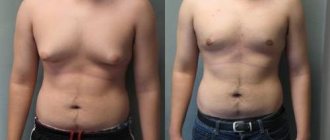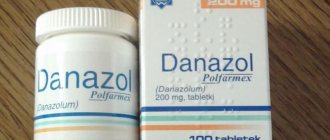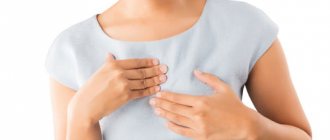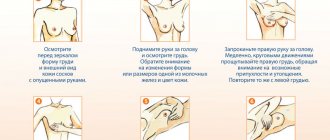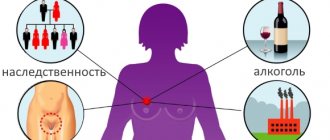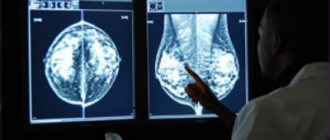Many girls and their mothers are interested in a rather interesting question - when girls’ mammary glands begin to grow. And this is completely natural. After all, puberty in girls is much more difficult than in boys. Therefore, it requires special attention.
In addition, it is necessary to closely monitor the development of the mammary glands in girls due to the fact that in recent decades women’s health has been characterized by decreased indicators. Monitoring the growth of a woman's breasts will make it possible to prevent possible disturbances in the functioning of the reproductive and endocrine systems of the future woman. In this article, we will consider at what age breasts begin to grow, signs of breast development and the stages of its formation.
The period when breast growth begins and stops
This question is not uncommon. However, there is no exact answer to this. This is due to the fact that in girls the timing of sexual development and its onset is very individual. The development of the mammary glands and the completion of their growth depend on the individual set of hormones in the body. Thus, in sexual terms, some adolescents mature by the age of 9, while others can only reach this phase by the age of 12.
Along with the beginning of breast development, the girl also exhibits other signs of puberty:
- hair growth in the pubic area and armpits;
- pronounced increase in sweating;
- the beginning of the formation of the menstrual cycle;
- increase in volume in the hips and pelvis.
The development of the bust in girls is completed due to the end of puberty. On average, this period occurs at 16 years. However, doctors do not consider the achievement of sexual development within 17-20 years to be a significant deviation from the norm. Later, you should not expect any serious changes in the mammary glands.
According to doctors, the end of growth of female mammary glands can be roughly calculated using the following formula: the beginning of menstruation plus 3-5 years. But you should not assume that after this period of time the mammary glands will not undergo changes. Since the female breast has a close relationship with the reproductive organs and the endocrine gland, it will be subject to some modifications throughout its life.
https://youtu.be/F-3iFrYzFSw
How long does it take for mammary glands to finally form?
The concept of “final size” for mammary glands is relative. More often, this worries those girls who consider their breasts to be small or, on the contrary, are looking forward to when they will stop growing.
The actual formation may stop 1 to 2 years after the menstrual cycle has stabilized. If menstruation began at the age of 12-13, by the age of 16 they become regular as the hormones come to balance. During this same period, most girls stop growing breasts.
But it is not at all necessary that for everyone the process ends exactly then. For some, hormone balance remains unstable longer. The mammary glands also experience the influence of these substances, so they will develop until the age of 20–22.
Schematically, their growth in terms of time can be described as follows:
- 10 - 11 years old, the first signs of development are detected (change in color of the nipples and the appearance of swelling);
- from 12 to 13 the size increases and the shape of the breast changes to conical;
- up to 14 years, it increases in volume, acquiring greater roundness;
- By the age of 15-16, the bust is completely formed and rapid growth is completed.
Stages of development
Each woman has her own individual hormonal balance, so breast growth occurs differently for all representatives of the fair sex. However, in its formation, this part of the body goes through several identical stages. Below are the stages of female bust formation identified by doctors.
From birth to 10 years
Initially, newborn boys and girls have breasts that are no different. Only in girls in the chest area can you barely notice traces of the milk line, which is located in the lower part of the nipples. Over time, her breasts will begin to form from this area. Some newborn girls may experience discharge from the nipple in the first days after birth. In medicine, this is not considered some kind of pathology.
By the end of this stage of breast formation, the glandular tissue is still undeveloped. Only a slight hardening of the nipple occurs.
Beginning of puberty
The bust of a teenage girl begins to change noticeably at the age of 12-13 years. This happens due to the restructuring of her hormonal levels and the beginning of puberty as a schoolgirl.
As a rule, this stage is accompanied by unpleasant and painful sensations in the chest area. This occurs due to stretching of the skin, which can also be accompanied by itching and burning. The girl's nipple takes on a more rounded shape, and the mammary glands themselves become elastic and slightly soft. For those teenagers whose puberty occurs much later, the breasts may become slightly denser, but their shape may not change at all.
Puberty
At the age of 13-15 years, active growth of the mammary glands and a significant increase in connective tissue are observed. The girl's breast takes on the shape of a cone, and her nipple becomes rounded. The pain becomes much stronger than in the previous phase. The girl is haunted by unpleasant discomfort due to a feeling of compression in the chest area. This occurs due to the rapid growth of ducts in the mammary glands. The bust of a young girl can increase by one size even in one day.
Completion of puberty
From the age of 15-16 years, a girl enters reproductive age. At this stage, the ducts in the mammary gland continue to actively grow, and the surface tissue of the breast stretches and thins. Blood vessels become visible through them. The painful sensations do not leave the girl. By the end of this stage, the girl’s breasts are rounded and take on the shape of an adult woman. The nipples and the circle around them acquire clearer lines and darker pigmentation. The size and proportions of a woman’s bust no longer change and remain the same until pregnancy and childbirth.
Transformation from girl to woman
At an early age, girls' breasts are no different from boys' breasts. The first changes begin to occur between the ages of 8 and 10 years. The amount of estrogen in the body begins to increase, which is why the breast tissue begins to gradually increase. It is the growth of the areola and nipple that characterizes the beginning of a girl’s puberty and the growth of her breasts. The color of the areola can be influenced by a number of factors, such as race and skin color. The nipple area is characterized by a pale pink color with a slight tint of brown. Girls should not panic if their areolas suddenly darken. There is nothing dangerous in this, since changes in color are characterized by the individual characteristics of the female body. Then, tubercles resembling small bumps begin to appear in the areola area. These glands are responsible for secreting sebum, which acts as a lubricant for the skin. Thanks to its presence, the skin around the nipple is always moisturized and does not crack.
Signs characteristic of breast growth
Typically, signs that a girl's breasts are growing appear within several years. Active growth can be recognized by the following specific features:
- The main and important symptom of breast growth is the appearance of unpleasant pain in this area. If a girl is very bothered by chest pain, it is recommended to visit a pediatric gynecologist.
- When feeling the breasts, slight enlargements are noticeable in the area of the nipples.
- The nipples become quite sensitive and more pronounced. Now they can be seen even through clothes.
- Darkening of the breast halos occurs.
- Small hairs may appear on the chest. It's completely natural.
- Small dots and bumps will appear on the areolas. These are the exits of glands that will subsequently moisturize the nipples. This property will be very useful after the birth of the baby.
- One breast may become slightly larger than the other.
- Itching with burning may be present.
- With rapid breast growth, small stretch marks may appear on it. In this case, it is necessary to use moisturizing creams.
Many girls are afraid of the changes happening to them. To reassure them, parents need to talk to the teenager and explain that all these are natural processes. She is simply beginning to become a woman. Parents should also understand that such changes are just the beginning and support the child.
Breast involution
After 40 years and before menopause, breast development occurs. The function of the gonads fades, the amount of glandular tissue decreases, it is gradually replaced by connective and adipose tissue. Skin tone decreases, breasts undergo ptosis (drooping). During this period, it is especially important to monitor the appearance of neoplasms in the glands, attend preventive examinations and undergo mammography. Involutive processes are not a pathological condition, but reflect the natural attenuation of the reproductive function of the body. With the onset of menopause, the breasts increasingly lose their elasticity, and ptosis intensifies. But don’t worry, thanks to the achievements of modern plastic surgery, any woman can restore the aesthetic appeal of her bust.
Every little girl looks with envy at an already matured woman and dreams of the time when she herself will have breasts. With the process of growing up, this topic increasingly excites the minds of growing girls, because breasts are the basis of a woman’s figure.
Factors influencing growth
Women have different bust sizes. The shape and volume of the breast depends on the following factors:
- Heredity . Representatives of the same family usually have the same bust size. If a girl’s mother and grandmothers have small breasts, then with a high probability she will have the same.
- Hormonal background . Each girl, due to differences in physiology, also has differences in hormones. If there is a lack of female hormones in the blood, breasts may develop slowly or not develop at all.
- Nutrition. A balanced diet for a teenager is also an important factor influencing breast growth. If a girl is too thin, due to a lack of fatty tissue in the body, the bust cannot fully develop. However, even in case of excess weight, the development of milk ducts occurs in conditions of deviation from the norm. In the future, this may make it difficult for the baby to feed naturally.
- Additional factors . It is necessary to take into account the influence on the development of female breasts and the following factors:
- Nationality and place of residence . In southern latitudes, girls, as a rule, reach puberty much earlier than their peers from the northern regions.
- Environmental ecology . The development of the bust can be negatively affected by environmental pollution. Due to poor ecology, a girl can develop many endocrine diseases associated with disruption of the thyroid gland. As a result, puberty occurs with pathologies.
- Physical activity . Undoubtedly, a lack of physical activity in adolescents negatively affects the development of the entire organism, including puberty. Moderate sports activities and training not only maintain muscle tone, but also affect the development, fit and elasticity of the bust.
What determines breast size?
Breast size depends on heredity. If no one’s mother or female relatives have large curves, then you shouldn’t expect them to appear in girls either. But this is individual, because a girl can inherit her size from her father. Some girls worry that they have small breasts, but do not forget that the mammary gland grows until the age of 21.
There are also myths about breast size. For example, to enlarge your breasts, you need to eat cabbage or drink a decoction of hop cones and many others. This is not entirely true. Breast enlargement is possible, but only with the help of other methods. Strong physical activity and special exercises will help train the pectoral muscles. Push-ups and exercises with dumbbells have a similar effect.
You should not abuse diets, especially during puberty and growth of the body. There is adipose tissue in the mammary gland, and if a girl loses weight, her bust sags. Therefore, you need to lose weight gradually. You should eat protein foods and vitamins - this is useful during the growth period of the body.
The last stage of breast formation occurs during pregnancy and lactation. After these processes, it will become clear what the breasts will remain like. It can either increase or decrease. Unfortunately, even at an early age during puberty, girls can develop diseases and pathologies. From 5% to 12% of schoolgirls are registered with a pediatric gynecologist with various diagnoses related to breast growth.
Diseases can be inherited. They are usually detected during puberty. If breast growth begins prematurely—before age 9—this may be a sign of early puberty. Breasts begin to grow early due to external factors: chemicals, GMO products, poor environment, etc. For effective treatment, these factors should be excluded. Breast diseases should be treated under the supervision of a physician.
Reasons for lack of development
Women's mammary glands may slow down their development or stop growing altogether. This occurs when there are significant deviations in a girl’s sexual development. As a rule, they are associated with a lack of female sex hormones - estrogens - in the body.
If you suspect slower breast growth, you must definitely visit an endocrinologist . After all, the hormonal imbalance in the body has a great impact on the entire subsequent life of a woman as a mother. It is likely that the specialist will prescribe hormones to the girl in the form of injections.
What is considered pathology?
A number of different reasons can cause the development of pathologies during the growth of the mammary glands. Such pathological conditions can be divided into several groups:
- developmental defects;
- diseases of an inflammatory and other nature;
- damage.
The breasts develop incorrectly and grow poorly when defects are detected, in particular:
- atelia (lack of nipple);
- presence of multiple nipples (polythelia);
- the presence of pathologies in the mammary glands (polymastia);
- absence of the superficial part of the mammary gland (amastia).
Various injuries and damage to the mammary glands can lead to slow growth or lack of growth:
- severe burns;
- pustular wounds;
- fistulas;
- bruises.
Also, pathological breast development can be caused by a number of diseases:
- hypermastia;
- mastopathy;
- hypomastia;
- telitis;
- gynecomastia;
- galactorrhea;
- thrombophlebitis;
- actinomycosis;
- papillary fissures, etc.
Benign tumors can form in the mammary glands. They can only be removed through surgery, which also affects the size and shape of the breast. A number of the above diseases can occur only as a result of disruption of the functioning of the endocrine system.
Girls consider breasts to be a true decoration that attracts the admiring glances of members of the opposite sex. The mammary glands require careful care and periodic examination. If you notice any abnormalities in breast development, contact your healthcare professional immediately.
The formation of mammary glands is a complex five-step process that raises many questions: when does breast growth begin, and what exactly is its catalyst? Why do some girls develop mammary glands earlier, while others develop later? How to care for growing breasts, when to buy underwear, and which changes are normal and which are a reason to see a doctor?
Growth stimulation methods
The shape and size of the bust are largely determined by heredity and national factors. Therefore, with all the desire, not everyone can become the owner of curvaceous figures. However, the attractiveness of a woman’s breasts is assessed not so much by its volume as by its elasticity and fit. Therefore, the formation of beautiful breasts in girls can still be influenced. To have a beautiful bust, you need to follow the recommendations for proper nutrition and regularly engage in active training.
Supply system
A healthy and balanced diet cannot significantly enlarge your breasts, but it does contribute to their proper development.
During puberty, nutritionists advise girls to include the following foods in their diet:
- Flax seeds, walnuts, greens, pumpkin, soybeans, which have phytohormones.
- Cabbage, legumes, grains that contain folic acid. It helps cell renewal and is generally very beneficial for the female body.
- Fruits and vegetables that are red and orange in color.
- Lots of clean still water.
Sports training
At the stage of breast growth, girls should engage in active training, which should be focused on strengthening the chest muscles.
Among the sports exercises that help maintain toned pectoral muscles, the following are the most effective:
- push-ups from the floor or from a bench;
- ball squeezing exercises;
- jumping rope.
It is worth noting that exercises should be performed regularly, but excessive loads are not recommended. For good results, no more than 3 sessions per week are enough.
Puberty
Puberty period (10 - 15 years). This period is characterized by their compaction, increasing engorgement, darkening of the nipple area, proliferation of adipose tissue and an increase in breast volume. If you feel the area around the nipple at this time, you can feel a rather hard lump of glandular tissue - the main “building material” of the mammary gland.
The changes are often asymmetrical, which worries teenagers themselves and their parents. During this period, breast growth is accompanied by feelings of heaviness, engorgement or mild soreness. Let us emphasize right away: these phenomena are of a normal physiological nature.
What to avoid
Many young girls mistakenly believe that they can increase their bust size through the use of hormonal drugs in the form of contraceptives. Under their influence, a girl's breasts may become larger due to deposits of fatty tissue, but deposits also form on other parts of the body, such as the hips, waist and buttocks. In addition, this effect ends immediately after stopping the use of the drugs. Experienced mammologists and gynecologists generally prohibit independently interfering with the natural hormonal levels during the development of the mammary glands. Otherwise, a teenager may develop pathologies in reproductive functions, including cancer.
Some teenage girls are very sensitive to their proportions. They seem imperfect to them in comparison with their peers and famous personalities. But psychologists note that at this age many people darken their lives with such trifles. They recommend that girls not focus on their appearance, but lead an active lifestyle and engage in their favorite hobbies.
Thus, the size and development of the bust is not the most important thing for a girl’s external beauty. But it can make a significant difference to your health. In adolescence, when assessing the development of the mammary gland, you need to focus primarily on this, and not on the aesthetic side of the issue. And if you have any problems or suspicions, do not hesitate to consult a doctor.
Choosing a bra
At what age should a girl start to think about choosing a bra and how to choose it correctly? Depending on the size of a girl’s breasts and when they began to develop, she can try on her first bra at the age of 11-12. It is especially important that it is not too tight and tight, otherwise there is a high risk of damaging the mammary glands during adolescence.
It is not advisable to wear fashionable models of lingerie with inserted linings to visually increase the volume of the bust for more than 3 hours a day. They disrupt the blood supply in this area and contribute to improper development and formation of the mammary glands.
Lingerie should be selected according to size, comfort and personal preferences.
What to do to make your breasts grow?
Every girl asked this question at least once at her tender age, when her figure is just beginning to take shape. At this age, and even with raging hormones in the body, young representatives of the fair sex are especially impressionable.
Some people later realize that a small bust is not a problem, and sometimes an advantage. For those ladies who don’t know what to do if their breasts are not growing, you can try the following:
- The fastest way, which, moreover, does not require extra effort. To increase volume, just go to a lingerie store and buy a bra with a push-up effect. Instant results are guaranteed. However, it can be very awkward when the deception is revealed to a man, and he will be upset not so much by the difference he saw, but by the fact that the girl he loved deceived him.
- You can give preference to a set of exercises. In this case, nothing can be done with the breast itself, since inside there are only mammary glands that rest in fat layers. And as you know, fat cannot be pumped up without surgery. But you can pump up your chest muscles. The most famous and simple exercise is called “prayer.” The hands are folded as in prayer, with the elbows pointing in opposite directions. Now we press both hands on each other at the same time. This simple exercise can be done anywhere and anytime. When doing physical exercise, it would be a big mistake to go on a diet - you can’t do this! You need to follow a balanced diet rich in proteins and carbohydrates.
- Medicine does not stand still and is actively developing in all directions that can help a person even with such a delicate issue as bust size. There is such an invention as vacuum nozzles. It is used as follows: a special cup is applied to each breast in turn, after which the air is pumped out of it. But the results from this method will not last long, only a few hours, but use can lead to problems with the health of the breast and sagging.
- Also on the cosmetology market there are many creams that help increase the coveted volumes. But you need to be careful with them, since most of them are hormonal. Therefore, the use of such drugs is possible only after consultation with your doctor.
- The most radical, expensive, but effective and at the same time dangerous method is plastic surgery. However, girls should remember that numerous surveys have shown that men in most cases like natural, medium-sized breasts.
This condition usually resolves on its own—medication and additional tests are not required. The mammary glands in girls (most often) stop growing during the year and may even return to their previous size, so that later, at the right age (at about 10–11 years), “real” puberty begins.
As practice shows, complications after PIT are rare. In one study conducted by Russian scientists, out of 106 girls with premature isolated thelarche, 71 began normal puberty at the right time. 22 were diagnosed with fibrocystic disease (benign neoplasm in the mammary glands). Eleven had the full form of precocious puberty. On the contrary, two girls experienced delayed puberty.
“Many parents of girls are faced with this harmless condition. They often get scared and start running to doctors and undergoing painful and expensive tests. Often even pediatricians do not know what to do about it. Parents have time to be “scared” enough until they get to an endocrinologist, where they are finally reassured, says Sergei Butriy.
How to make mammary glands grow? What needs to be done to develop large and beautiful breasts? It is important to understand exactly what factors influence bust growth in women. Is it possible to influence the main factors of breast growth to increase bust size? Let's figure out what can be done to increase the size of the mammary glands.
Hormonal drugs for breast growth
The formation of secondary sexual characteristics depends on hormonal levels, both in girls and boys. However, the amount and set of sex hormones in male and female bodies differ. In girls, estrogen predominates, and in boys, testosterone predominates.
Thus, estrogen has the main influence on the growth of mammary glands in adolescence (12-15 years). This substance is constantly produced in the body of a woman of fertile (childbearing) age. However, the intensity and amount of the hormone produced may differ at different periods of a woman’s life: puberty, pregnancy, menopause.
Many women decide to increase their bust size with the help of hormonal drugs. However, is it as safe as it seems? Of course, you can make your breasts grow with pills. However, you need to understand that this must be done competently and only after consultation with a gynecologist-endocrinologist. Why?
It is believed that the growth of a woman's bust is also influenced by diet. From a scientific point of view, this is explained by the fact that a number of products contain phytoestrogens. These substances act on the body like estrogens. For the full development of the breast (especially from 12-13 years to 14-15), the intake of nutrients, vitamins and minerals into the body is important.
Scientists have proven that ecology and living conditions have a certain influence on the growth of a woman’s bust, as well as the body as a whole. It is not for nothing that women with curvaceous figures are most often found in rural areas, and residents of dusty cities have small breasts.
Genetic characteristics and breast growth
It has been proven that breast growth is also significantly influenced by genetic predisposition. Thus, if all women in the family have breasts of size 2-3, then it is stupid to hope for a bust size of 5-6 and try to do something for this (except for surgery, of course). However, if you eat right at the age of 12-15, constantly take care of your breasts, do regular massages and contrast showers, and also choose the right underwear, you can achieve your genetic maximum in bust volume. By the way, the age at which a woman’s breasts grow depends on genetics.
It was also noticed that residents of the eastern and southern regions have larger mammary glands than women from the north and west. Unfortunately, it is not possible to influence this factor.
Breast anatomy of a nursing mother
Author: Anna Edgar
Editor's note. It is very important to remember that breastfeeding is not a theory, but a practice. The scientific evidence that emerges every day merely explains what breastfeeding mothers have long learned through experience through centuries of breastfeeding. Feeding is a relationship between mother and baby, an interconnected system that works as both mother and baby learn to understand each other. Look at the child and you will never go wrong!
Scientific data answers our questions, but is not always correct. Knowledge of breast anatomy, not to mention the physiology of lactation, is changing even today. Just recently, Australian scientists have refuted the knowledge about the structure of lactating breasts, which has dominated for 160 years!
See how the old ideas about the anatomy of the lactating breast differ from the new ones. Key points: (1) the milk ducts branch closer to the nipple; (2) lacteal sinuses do not exist; (3) glandular tissue is located closer to the nipple; (4) there is almost no subcutaneous fat at the base of the nipple. The ratio of glandular tissue to fat is 2:1. 65% of all glandular tissue is located within a radius of 30mm from the base of the nipple. There are 4-18 milk ducts in the nipple. The complex duct system is neither symmetrical nor radial (Medela 2006).
Many of us know that breastfeeding is both nourishment, normal baby food, and a convenient way to love, nurture and care for a child. Do you know how the nursing breast works, how milk appears in it? The baby sucked all the milk, and the breasts became full again. Why do the breasts fill up again after emptying? What did our ancestors think about this? What do we know today? You will find answers to all these questions in this article. As you learn how a breastfeeding mother's breasts work, you will come to appreciate even more the amazing process of breastfeeding, nursing breasts, and nursing mothers who nurture new life outside the womb.
From the history
For thousands of years, people have been interested in the anatomy and physiology of the breast. The earliest medical documentation of female breasts dates back to ancient Egypt. They describe how to determine whether a mother's milk is good or bad, and how to increase its quantity. The author recommends rubbing fish oil on the mother's back while she "sits cross-legged... rubbing her chest with a poppy plant" to increase milk flow (Fildes 1985). Marilyn Yalom, author of A History of the Breast, explains, “At a minimum, both methods helped the mother relax,” which in turn promoted milk let-down (the milk ejection reflex), but they likely did not affect milk production. The ancient physician Hippocrates (460-377 BC) believed that menstrual blood was somehow converted into milk. This point of view prevailed right up to the 17th century! During the Renaissance, Leonardo da Vinci (1452-1519) drew veins connecting the uterus and chest in his anatomical drawings.
Even the philosopher Aristotle (384-322 BC) wrote about breastfeeding. He believed that dark-skinned women had healthier milk than white-skinned women, and that children who drank warmer mother's milk cut teeth earlier. (He was wrong on both counts.) Aristotle also believed that children should not be given colostrum to drink. This misconception still persists in some cultures. Soranus, an ancient gynecologist (practicing in 100-140), recommended breast massage and forced vomiting as a means to increase milk supply. However, he did not advise drinking “drinks containing the ashes of burnt owls and bats” (Soranus 1991). By the 16th century, discoveries about breast anatomy began to move in the direction of today's understanding. Studies of corpses showed that the breasts consisted of glandular tissue, which, as scientists of the time concluded, “converts the blood going to the chest through the veins into milk” (Vesalius 1969).
Many early documents on breastfeeding deal with the topic of wet nurses: women who were hired to breastfeed someone else's child. Nurses are mentioned in Hammurabi's code of laws (1700 BC), the Bible, the Koran and the works of Homer. There were clear regulations on what qualities the best wet nurses should have, from hair color, breast shape and appearance, to the gender of the wet nurse's children (Yalom 1997). Beginning in the 18th century, doctors finally began to understand that it was better for a mother's health to feed her baby herself rather than relying on a wet nurse, and that maternal colostrum was beneficial for the baby (Riordan 2005).
Over the past 50 years, medical science has learned much more about human milk, especially in the field of immunology. Today it is known that colostrum contains a huge concentration of antibodies that protect the newborn from disease; that the composition and proportions of nutrients in milk are the standard of nutrition for infants and children; and that after a year, when the child suckles less often, the concentration of immune factors in the milk increases. If a woman gives birth prematurely, her milk is different in composition from the milk of a woman who gave birth at term. The milk of the mother of a premature baby is adapted to the needs of such a vulnerable baby. In the book “The Female Art of Breastfeeding” it is written: “No two mothers have the same milk... The composition of human milk changes from day to day and differs even depending on the time of day... The colostrum that the baby sucks on the first day of life is different from the colostrum on the second or the third day."
Human milk is a complex living substance that lays the foundation for the health and optimal development of young children.
Breast development
Breasts begin to develop in the womb of both male and female fetuses. Between 4 and 7 weeks of embryonic life, the outer skin begins to thicken along a line from the armpit to the groin area. This is how milk folds or milk lines are formed. Later, most of these “milk lines” disappear, but a small part in the breast area remains, and here from 16 to 24 mammary buds are formed, which develop and turn into milk ducts and alveoli - the sacs in which milk is produced and stored.
The milk ducts initially lead to a small depression under the skin, but soon after birth a nipple forms at this site (Sadler 2000). The nipple is surrounded by an areola. After this, the development of the mammary gland stops until puberty.
The next stage of breast development occurs when girls begin puberty, at approximately 10 to 12 years of age. Breasts begin to grow a year or two before the start of menstruation. Breast tissue grows a little during each ovulatory cycle. Most breast growth occurs during puberty but continues until approximately 35 years of age (Riordan 2005). Breasts are not considered fully mature until a woman has given birth and begins producing milk (Love & Lindsey 1995).
In the book “Breastfeeding. Questions and answers." (THE BREASTFEEDING ANSWER BOOK) it is written that the mature breast consists of glandular tissue for the production and movement of milk; supporting connective tissue; blood, which supplies nutrients needed for milk production; lymph - a fluid that removes waste products through the body's lymphatic system; nerves that send signals to the brain; and adipose tissue, which protects against damage (Mohrbacher & Stock 2003). Glandular tissue consists of alveoli, which produce and store milk until the surrounding muscle cells push the milk into the small (alveolar) ducts. The small ducts then merge into larger ducts, which open into 5-10 milk pores at the tip of the nipple. Until recently, it was believed that in addition to the alveoli, milk was also stored in the lactiferous sinuses, extensions of the ducts in front of the nipple. However, recent ultrasound studies have shown that the lacteal sinuses are not permanent structures of the breast (Kent 2002). The milk ducts under the nipple widen under the influence of the milk ejection reflex, but narrow again after feeding, when the remaining milk returns back to the alveoli. (Editor's note: Recent research shows that the lacteal sinuses do not exist at all (Ramsey, Kent 2005)).
The structure of the breast can be compared to a tree. Alveoli are leaves, ducts are branches. Many small branches merge to form several large branches, which in turn form the trunk. Like the branches of a tree, the chest consists of lobules, each of which is formed from one large duct with many small ducts and alveoli connected to them. Most experts believe that women have 15 to 20 of these lobes in each breast, but one recent study suggests that there are more likely 7 to 10 of them in each breast (Kent 2002).
The areola or areola, the dark area around the nipple, gets its coloration from the pigments eumelanin and pheomelanin. The areola contains sebaceous glands (which secrete oil that softens and protects the skin), sweat glands, and Montgomery glands, which secrete a substance that lubricates the nipple and protects it from bacteria.
Pregnancy and lactation
During pregnancy, the breasts change greatly under the influence of pregnancy hormones, which include estrogen, progesterone, and prolactin. Each hormone plays a specific role in preparing the body for breastfeeding. The most noticeable change is breast enlargement. During the first trimester of pregnancy, ducts and alveoli grow and branch at a high rate. Many women note that their breasts have become more sensitive.
Lactogenesis is the term to describe the onset of lactation. There are three stages of lactogenesis. The first stage begins approximately 12 weeks before birth, when the mammary glands begin to produce colostrum. The breasts become even larger as the alveoli fill with colostrum, but due to high levels of progesterone in the mother's blood, milk is not produced in full until the baby is born.
The second stage of lactogenesis begins after the birth or separation of the placenta. Progesterone levels drop while prolactin levels remain high. Prolactin is the main hormone of lactation. It is produced under the influence of the hormones of the pituitary gland, thyroid gland, adrenal glands, ovaries and pancreas. More oxygen-rich blood flows to the chest. 2-3 days after birth, milk “comes in.” The amount of milk increases rapidly, the composition of the milk changes: colostrum is gradually replaced by “mature” milk. The amount of sodium, chlorine and protein in milk decreases, and the amount of lactose and other nutrients increases. The color changes from golden yellow, the typical color of colostrum, to a bluish white. Since at this stage of lactogenesis, milk production is under the influence of hormones, milk is produced in the breast regardless of whether the mother is breastfeeding or not. It is very important to feed frequently during this time (and/or pump if baby is not latching or is not latching well), as frequent feedings in the first week after birth are thought to increase the number of prolactin receptors in the breasts. Receptors recognize a specific hormone and respond to it. The more prolactin receptors there are, the more sensitive the mammary glands are to prolactin, which, according to researchers, affects the amount of milk produced by the mother at the next stage of lactogenesis.
The third stage of lactogenesis is also known as milk production. At this stage, the production of mature milk is established. Now milk is produced not under the influence of hormones (endocrine control), but under autocrine control. This means that continued milk production depends more on how empty the breasts are, rather than on the level of hormones in the blood. Milk is produced according to the principle “demand creates supply”, namely the more the mother breastfeeds, i.e. The more the baby sucks, the more milk will be produced. And accordingly, the less you feed, the less milk there will be.
Physiology and milk quantity
Understanding the process of milk production can help a mother organize breastfeeding so that her baby always has enough milk. For example, sometimes a woman feels that the baby has completely emptied the breast and there is absolutely nothing left in it, although the baby has not yet had enough. If a mother knows that milk is constantly being produced in the alveoli, she will confidently give her baby the breast, even if it seems “empty.” One study found that on average, babies sucked only 76% of the milk currently in the breast per day (Hartmann et al.1993)
Milk production depends on how empty the breasts are. When a baby suckles, a signal is sent to the mother's brain that triggers the release of the hormone oxytocin. The release of oxytocin into the blood causes the muscle cells around the alveoli to contract, causing milk to be pushed out through the ducts to the nipple. This is the milk ejection reflex. At this moment, a woman may feel a tingling sensation in her breasts or feel the milk flowing in, so this reflex is called a tide. During high tide, the alveoli are emptied, and milk flows to the nipple, from where the baby sucks it out. When the alveoli are empty, they produce more milk. Recent research has revealed that human milk contains an organic compound called a feedback inhibitor of lactation, which regulates milk production (Wilde 1995). When there is a lot of milk in the breast, this protein signals the alveoli to stop producing milk. Once the baby has emptied the breast, and therefore there is no longer the “lactation inhibitor” that stops milk production, the alveoli begin to produce milk again. This is why it is so important to put your baby to the breast frequently and allow him to empty the breast as much as possible to ensure an optimal milk supply.
Another factor that affects the amount of milk is the storage capacity of the breast. Sometimes women with small breasts worry that they will not have enough milk. These worries are in vain: the amount of milk does not depend on the size of the breast. It is possible that a small breast may not store as much milk between feedings as a large breast, but if you put your baby to the breast frequently, there will be just as much milk as your baby needs. Women with larger breasts and greater breast storage capacity can afford to breastfeed less frequently and this may not affect their milk supply. On the other hand, some women with small breasts need to breastfeed more often because their breasts fill faster and their milk production slows down as their sacs fill. Frequent breastfeeding not only has a positive effect on milk supply, it is also good for preventing congestion and breast infections. (Editor's note: Research shows that "external breast size was not a reliable indicator of milk supply and breast capacity, and that all women produced enough milk per day" [regardless of breast size]).
Does a mother need to know how much milk is in her breasts at one feeding to determine how often she should feed her baby? Definitely not. Healthy babies suck out exactly as much milk as they need and when they need it, and mothers don’t even have to rack their brains about what’s happening in the breast. An idea of how nursing breasts work can only be useful in cases where a woman needs to figure out why she doesn’t have enough milk. In addition, this knowledge will help a woman analyze myths and misconceptions about breastfeeding. For example, she will know that she does not have to wait between feedings for her breasts to “fill up”—there is always milk in the breasts. The theory will also be a good help in cases where the child seems hungry or has a growth spurt: the woman will confidently feed one more time, because... knows that more frequent feedings will almost immediately speed up milk production.
How do different substances pass into breast milk?
Understanding the mechanism of milk production helps the mother understand how various substances (proteins, as well as harmful substances or drugs) enter the milk. This will help a woman decide how to eat, receive treatment, and what lifestyle to lead when she is breastfeeding.
How do different substances get into milk? When a woman takes medicine or eats food, they are broken down in the gastrointestinal tract (GIT), and then the molecules of these substances are absorbed into the blood. Together with the blood, the molecules enter the capillaries of the breast tissue, where they penetrate into the milk through the cells lining the alveoli. This process is called diffusion.
Diffusion process
This is how various components of milk, as well as medications and other substances, enter the milk. However, whether this or that substance gets into milk, and in what quantity, depends on many factors. In the first days after birth, there are gaps between lactocytes, the cells that line the alveoli and block or allow various substances to pass through. Therefore, in the first days after birth, substances can penetrate into milk more freely. After a few days, the lactocyte gaps close. From this point on, it is more difficult for various substances to penetrate the barrier between blood and milk (blood-milk barrier).
Thanks to the process of diffusion, various useful components, such as antibodies, enter colostrum and mature milk. Antibodies are protein molecules that are part of the blood and help the body fight infection. In human milk, the highest concentration of antibodies occurs at the beginning and end of lactation. Very important antibodies - secretory immunoglobulin A (SIgA) - are synthesized and stored in the breast. In addition to SIgA, milk contains about 50 antibacterial factors, many of which come from maternal blood. And this does not include those factors that have not yet been discovered! Antibodies and antibacterial factors are one of the most important benefits of breastfeeding. All women pass on antibodies to their babies during pregnancy and childbirth, but breastfeeding helps the mother protect her baby from disease even longer.
As a result of diffusion, substances that may bother the baby also enter breast milk. Many people believe that if a mother eats gas-forming food, for example, cabbage (different types), the baby will also become bloated. Is it true? No. The gases themselves do not penetrate into the blood from the gastrointestinal tract, and therefore do not enter the milk. However, during the digestion of food, some proteins from the food enter the blood and then into the milk. Some babies react to certain types of protein: their tummy swells and they get restless. If the mother notices that after eating a certain food the baby has such a reaction, you can try to temporarily exclude this specific product from the diet. It is especially important to note here that in most children the cause of anxiety and gas formation lies in something else. Allergic reactions to certain substances in breast milk manifest themselves in the form of skin irritations, respiratory problems and gastrointestinal problems. If someone in the family is allergic to certain foods, the mother should abstain from them during the period of breastfeeding.
What does all this mean for a nursing mother? A nursing mother can eat whatever she wants and can be sure that most children will not react in any way to what they eat from their mother. (For more details, see the article “Allergies and the Infant Family” in the July-August 1998 edition of New Beginnings magazine.)
Medicines taken by a nursing mother can also penetrate the lactocyte barrier from the blood into the alveoli. The author of the book “Medicines and Mother's Milk,” Thomas Hale, writes that there are several factors that influence the passage of drugs into milk. The concentration of the drug in the mother's blood affects the amount of the drug that passes into the milk. If there is a high concentration of a drug in the blood, more of the drug will get into the milk, where the concentration is lower, through the process of diffusion. During the process of diffusion, the concentration of substances is maintained at the same level on both sides of the barrier. Therefore, as the concentration of a certain substance decreases in the mother's blood, particles of the same substance that entered the milk will return to the blood, and its concentration in the milk will also decrease. (Editor's note: How do you know when milk contains the most of a substance? This can be determined if you know the time of maximum concentration (Tmax) of the drug in the blood. Usually this information is in any pharmacological reference book. In practice, this means that feeding can be plan to avoid feeding at times when drug concentrations in the blood are highest.)
Why is it important to understand the diffusion process? Some mothers mistakenly think that after they drink a glass of wine, the alcohol will be in the milk until they express it. As a result, she doubts whether to feed the baby or express and discard the milk. In fact, the level of alcohol in milk will decrease at the same time as in the blood. For a woman weighing 54 kilograms, the amount of alcohol contained in one glass of wine or beer will disappear from the blood within 2-3 hours. After the same time, there will be no alcohol left in the milk. (Editor's note: You can determine when the concentration of a substance in milk decreases by looking in the pharmacological reference book. The half-life (T1/2) indicates the period of time during which the concentration of the drug in the body decreases by 50%.)
The extent to which a drug passes into mother's milk is also influenced by the molecular weight (actually the size of the molecule) of the substance that makes up the drug, protein binding, and fat solubility. Substances with low molecular weight penetrate into milk more easily. (Editor's note: Substances with a molecular weight of less than 200 easily penetrate into milk. If most of the drug is bound to proteins, the drug cannot penetrate into the milk, because the drug is “glued” to the protein, and there are no free drug molecules in the plasma, which could easily pass into milk if they were not bound to proteins. Milk contains more fat than plasma, so fat-soluble drugs can concentrate in milk fats. In the book "Drugs and Mother's Milk" T. Hale writes, that most medications are compatible with breastfeeding. If some medication is incompatible with breastfeeding, a suitable replacement can almost always be found. If a woman needs to take medications, she should consult a doctor. (For more information, see the article “Drug Therapy and the Breastfeeding Mother” in the November-December 2003 edition of New Beginnings magazine.)
Modern medicine has more knowledge about the physiological process of lactation than at any time in history. We have data about the structure of the breast, information about how the components of the breast work to produce milk. Compared to the past, we have a good understanding of how different substances get into mother's milk. Armed with knowledge, we can successfully manage breastfeeding, avoid unnecessary weaning, and resolve any problems that may arise during breastfeeding. This makes us appreciate the opportunity to breastfeed more when everything goes well!
Bibliography
Daly, SEJ, Owens, RA, and Hartmann, PE The short-term synthesis and infant-regulated removal of milk in lactating women. Exp Physiol 1993; 78(2):209-20. Fildes, V. Breasts, Bottles, and Babies: A History of Infant Feeding. Edinburgh, Scotland: Edinburgh University Press, 1985. Goldman, AS et al. Immunologic components in human milk during weaning. Acta Paediatr Scand 1983; 72(1):133-4. Hale, T. W. Medications and Mothers' Milk. Amarillo, Texas: Pharmasoft Publishing, 2004. Hartmann, P. E. et al. Breast development and control of milk synthesis. Food Nutr Bull 1996; 17:292-304. Kent, J. Physiology of the expression of breast milk, part 2. Presented at the Medela Innovations in Breast Pump Research Conference, Boca Raton, Florida, July 2002. Lesavoy, MA et al. Axillary breast tissue: Clinical presentation and surgical treatment. Ann Plast Surg 1995; 35:356-60. Love, S. and Lindsey, K. Dr. Susan Love's Breast Book. New York, New York: Addison Wesley, 1995. Mohrbacher, N. and Stock, J. THE BREASTFEEDING ANSWER BOOK. Schaumburg, IL: LLLI, 2003. Patnaik, P. Axillary and vulval breasts associated with pregnancy. Br J Obstet Gynaecol 1978; 85:156-7. Peaker, M., and Wilde, C. Milk secretion: Autocrine control. News Physiol Sci 1978; 2:124-26. Pittard, W. et al. The immunological composition of neonatal milk: Cellular components. Clin Immunol 1988; 46, 294-298. Sadler, T. W. Langmans Medical Embryology. Philadelphia, Pennsylvania: Lippincott, Williams, and Wilkins, 2000. Smith, L. J. How mother's milk is made. LEAVEN 2001; 37(3):54-55. Soranus. 1991. Gynecology. Translated by Owsei Temkin. Baltimore, Maryland: Johns Hopkins University Press. Velanovich, V. Ectopic breast tissue, supernumerary breasts, and supernumerary nipples. South Med J 1995; 88:903-6. Vesalius, A. 1969. The Epitome of Andreas Vesalius. Translated by L.R. Lind. Cambridge, MA: The MIT Press. Wilde, DJ et al. Autocrine regulation of milk secretion by a protein in milk. Biochem J 1995; 305:51. THE WOMANLY ART OF BREASTFEEDING. Schaumburg, Illinois: La Leche League International, 2004. Yalom, M. A History of the Breast. New York, New York: Alfred A. Knopf, 1997. Zeretzke, K. Allergies and the breastfeeding family. NEW BEGINNINGS 1998; 15(4):100.
Additional bibliography for editor's notes
Medela AG (2006). Anatomy of the Lactating Breast Poser. Ramsay DT, Kent JC, Hartmann RA, and Hartman PE. Anatomy of the lactating human breast redefined with ultrasound imaging. J Anat. 2005 June; 206(6): 525–534.
Diffusion diagram taken from Wikimedia Commons: Diffusion.jpg
Author: Anna Edgar Sebring, Florida, USA From NEW BEGINNINGS, ed. 22, No. 2, March-April 2005, pp. 44-50 Translation by Victoria Khudyakova with the participation of Maria Sorokina Edited translation by Natalia Gerbeda-Wilson Proofreader Alesya Brizhan
Why don't breasts grow?
Breast development stops due to heredity, hormonal imbalance and serious diseases.
Heredity
Genes determine not only skin or hair color, but also the size of the mammary glands. When breast size reaches a programmed limit, the brain stops the production of hormones responsible for its development.
Hormonal imbalance
Some girls begin puberty later than their peers. A delay of 2–3 years is considered normal. If, after 15, a girl’s breasts and pubic hair do not grow, or her periods do not come, she should consult a doctor.
Lack of menstruation and developmental delays may indicate a hormonal imbalance. He is called:
- obesity;
- B vitamin deficiency;
- liver problems and slow metabolism;
- diets and anorexia;
- some medications.
The doctor will determine the exact cause of the imbalance, recommend a diet, and, if necessary, select hormone replacement therapy.
Diseases
Breast growth stops with severe arthritis, cancer and somatotropin deficiency. The production of growth hormone is disrupted by inflammation of the colon, head injuries, infectious diseases, thyroid or adrenal insufficiency, and also due to genetic pathology.
Sometimes breast growth stops due to regular stress, abuse of caffeine and sugar, as well as lack of proteins, proper fats and an unbalanced diet.
What influences breast formation?
In the body of every girl, mammary glands are formed from birth. This process begins long before breast growth, so it will take a long time for them to increase in size. The development of functions in boys and girls proceeds completely differently, despite the external similarity of the mammary glands in childhood.
Breast formation is completed after all the hormonal changes of adolescence have ended. The development of the milk tubes is very slow, they atrophy until the woman becomes pregnant.
There are a number of signs that affect the enlargement or stagnation of breast growth. These include:
- High levels of hormones in the blood of a teenager. Their growth is caused by menstruation. It is possible that breasts at the age of 14 can become very large due to taking hormonal drugs, but as soon as they stop taking them, everything falls into place and this part of the body takes on its previous shape, characteristic of a little lady.
- Regular physical activity helps to visually enlarge the breasts, as the muscles located near the gland tighten. The breasts themselves cannot be enlarged in this way, since the gland does not have endocrine muscles.
- Breast size at 14 years old depends on the girl’s body weight; the more fat deposits in her body, the larger the glands will be. Diets at this age can negatively affect the normal functioning and formation of the mammary glands.
- Features of the structure of the human body. If a girl is small and thin, then her breasts will be small; for “plumpies,” this part of the body is always larger.
- Hereditary factor. What kind of breasts mother had, nature will reward her daughter with the same glands.
- Diet and body health. Avitaminosis. Lack of vitamins and nutrients negatively affects breast growth. Most often, the effect of slow breast growth is observed in countries with low living standards, where people cannot afford to eat healthy foods.
- Blame the chromosomes. Breasts do not grow if, at the time of conception, the chromosome set that is responsible for puberty does not side with female characteristics. In such a situation, the mammary glands either develop poorly or do not enlarge at all.
- An insufficient amount of the hormone estrogen, which is responsible for the development of endocrine glands, leads to slow breast growth. In the complete absence of this hormone, the processes of gland formation will not begin.
Poor nutrition, diets, or, conversely, excess body weight will make themselves felt and greatly affect the formation of glands. At this age, you should not be ashamed of one breast size; large “shapes” at this age indicate that in the future this part of the body will be prone to sagging.

